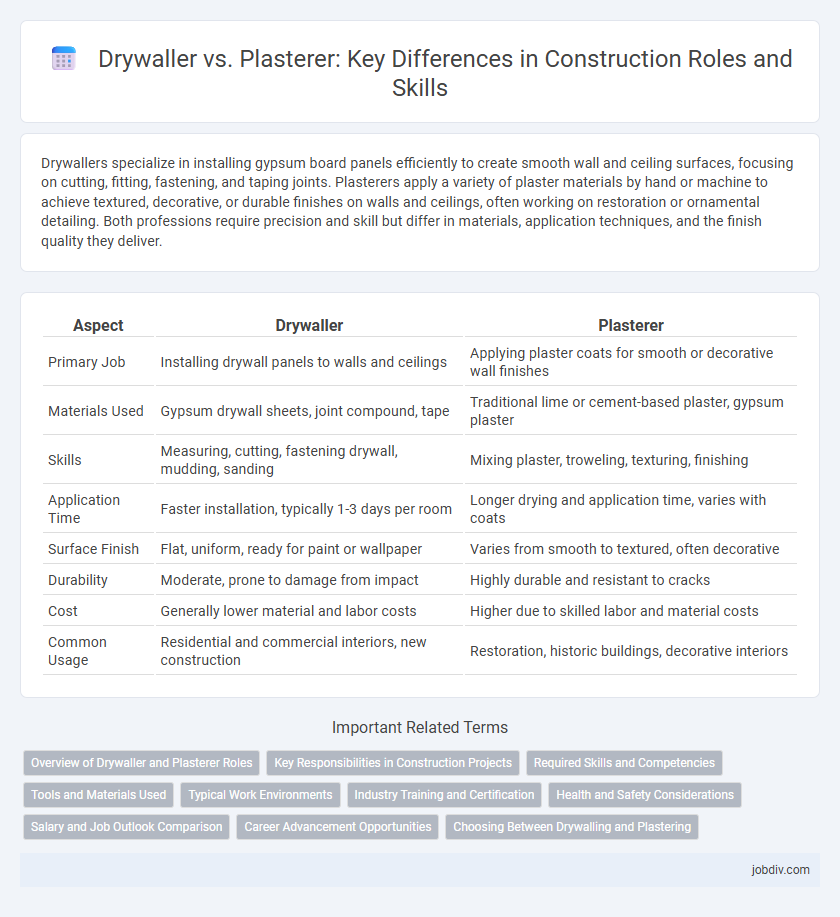Drywallers specialize in installing gypsum board panels efficiently to create smooth wall and ceiling surfaces, focusing on cutting, fitting, fastening, and taping joints. Plasterers apply a variety of plaster materials by hand or machine to achieve textured, decorative, or durable finishes on walls and ceilings, often working on restoration or ornamental detailing. Both professions require precision and skill but differ in materials, application techniques, and the finish quality they deliver.
Table of Comparison
| Aspect | Drywaller | Plasterer |
|---|---|---|
| Primary Job | Installing drywall panels to walls and ceilings | Applying plaster coats for smooth or decorative wall finishes |
| Materials Used | Gypsum drywall sheets, joint compound, tape | Traditional lime or cement-based plaster, gypsum plaster |
| Skills | Measuring, cutting, fastening drywall, mudding, sanding | Mixing plaster, troweling, texturing, finishing |
| Application Time | Faster installation, typically 1-3 days per room | Longer drying and application time, varies with coats |
| Surface Finish | Flat, uniform, ready for paint or wallpaper | Varies from smooth to textured, often decorative |
| Durability | Moderate, prone to damage from impact | Highly durable and resistant to cracks |
| Cost | Generally lower material and labor costs | Higher due to skilled labor and material costs |
| Common Usage | Residential and commercial interiors, new construction | Restoration, historic buildings, decorative interiors |
Overview of Drywaller and Plasterer Roles
Drywallers specialize in installing, finishing, and repairing gypsum board panels to create smooth wall surfaces essential in residential and commercial construction. Plasterers apply wet plaster mixtures to walls and ceilings, shaping textured or smooth finishes that enhance both aesthetics and durability. Both trades require precision and skill but differ primarily in materials and techniques used for wall surface preparation and finishing.
Key Responsibilities in Construction Projects
Drywallers specialize in installing gypsum boards to create smooth interior walls and ceilings, ensuring precise cutting, fitting, and fastening of panels. Plasterers apply layers of plaster or stucco to surfaces for a finished appearance, focusing on surface preparation, application, and texturing to achieve durability and aesthetic quality. Both roles require expertise in materials and techniques but differ in their approach to wall finishing and final surface treatment.
Required Skills and Competencies
Drywallers must excel in measuring, cutting, and installing gypsum panels with precision, ensuring smooth seams and proper fastening for a sturdy wall base. Plasterers require advanced skills in mixing plaster, applying multiple coats, and creating smooth or textured finishes that enhance durability and aesthetics. Both trades demand a keen eye for detail, manual dexterity, and thorough knowledge of building codes and safety standards, but plastering involves more artistic skill and finishing techniques compared to the technical installation emphasis of drywalling.
Tools and Materials Used
Drywallers primarily use drywall panels, joint compound, drywall tape, T-squares, and utility knives to install and finish interior walls and ceilings, focusing on achieving smooth, flat surfaces quickly. Plasterers work with materials such as lime, cement, gypsum plaster, trowels, hawks, and floats to apply and shape wet plaster for durable, textured finishes on walls and decorative moldings. The difference in tools and materials reflects drywallers' emphasis on speed and efficiency versus plasterers' focus on craftsmanship and texture.
Typical Work Environments
Drywallers primarily work indoors on residential, commercial, and industrial building sites, installing gypsum boards and preparing surfaces for finishing. Plasterers often operate both indoors and outdoors, applying decorative or protective coatings over walls and ceilings, including stucco or lime plaster. Both trades require working at heights, in confined spaces, and handling heavy materials, but plasterers may encounter more exterior work environments exposed to weather conditions.
Industry Training and Certification
Drywallers typically complete industry training through apprenticeships or technical schools, focusing on installing and finishing gypsum board systems with certifications such as the Certified Drywall Installer credential. Plasterers undergo specialized training that emphasizes the application and finishing of wet plaster surfaces, often acquiring certifications like the Plastering Apprenticeship Certificate or local trade licenses. Both professions require adherence to safety standards and mastery of materials, but certification programs differ based on the specific skills and techniques relevant to drywall installation versus plaster application.
Health and Safety Considerations
Drywallers and plasterers face distinct health and safety risks due to their materials and techniques; drywallers often encounter dust from gypsum boards which can cause respiratory issues, while plasterers are exposed to chemical additives and wet plaster that can irritate the skin and eyes. Proper use of personal protective equipment (PPE) such as masks, gloves, and eye protection is critical in minimizing these hazards on construction sites. Awareness of ventilation standards and safe handling procedures further reduces risks related to airborne particles and chemical exposure in both trades.
Salary and Job Outlook Comparison
Drywallers typically earn an average annual salary ranging from $35,000 to $55,000, with experienced professionals potentially reaching higher wages depending on location and project scale. Plasterers, often skilled in decorative finishes and restoration, tend to have a slightly higher salary range, approximately $40,000 to $60,000 annually, influenced by craftsmanship expertise and demand in historic or upscale markets. Job outlook for drywallers is projected to grow moderately due to ongoing residential and commercial construction, while plasterers may see steadier demand in specialty renovation projects and custom architectural work.
Career Advancement Opportunities
Drywallers often advance by specializing in commercial projects or transitioning into supervisory roles overseeing large-scale builds, leveraging expertise in installing gypsum boards. Plasterers can progress by mastering decorative plaster applications or restoration work, potentially moving into historical preservation and high-end residential markets. Both careers offer pathways to project management, but drywallers typically see faster growth in modern construction environments due to higher demand for drywall installation.
Choosing Between Drywalling and Plastering
Choosing between drywalling and plastering depends on project scope, budget, and desired finish quality. Drywall offers faster installation and cost-efficiency, making it ideal for large-scale commercial projects. Plastering provides a smoother, more durable surface with superior soundproofing, preferred in high-end residential and restoration works.
Drywaller vs Plasterer Infographic

 jobdiv.com
jobdiv.com